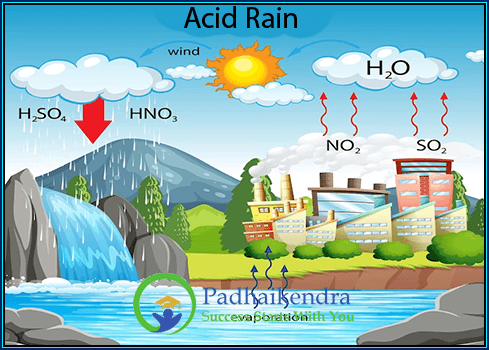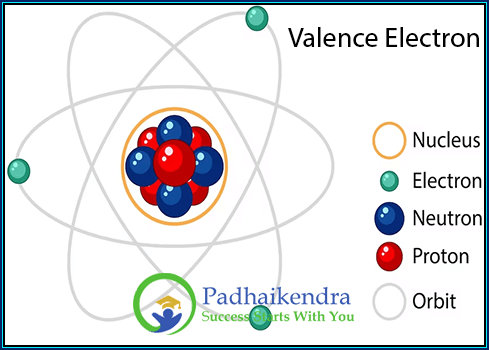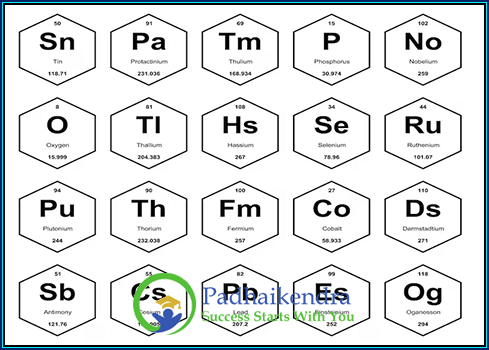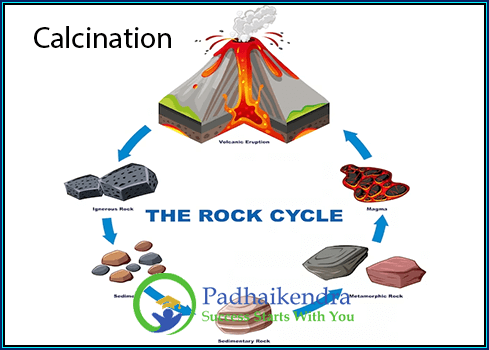Ques: What is Acid Dissociation in Water?
Sol: Solvated hydroxide and solvated protons are in equilibrium with liquid water. To define the concentration of these solvated ions in water, we usually use a value related to the equilibrium constant. The Kw constant for water dissociation is 1 x 10-14.
For acidic and basic solutions, pH and pOH are critical values. (The log base 10 of the hydrogen ion concentration and the log base 10 of the hydroxide ion concentration, respectively.)
pH = -log [H+]
pOH = -log [HO–]
14 = pH + pOH
The LeChateliers principle states that adding one of the products to an equilibrium system causes the equilibrium to shift towards reactants. Acids and bases dissolve in water and suppress water dissociation by increasing the concentration of one of the products of water self-ionization, either protons or hydroxide ions.
Acid and base solutions in water are typically described using pH and pOH. The concentration of solvated protons equals that of solvated hydroxide anions in pure water, and the pH is 7. The pH of acidic solutions is lower, whereas the pH of basic solutions is higher.
Definitions of Acid Dissociation Constant (Ka)
The concept of pKa is based on the thermodynamics of the dissociation reaction. The acid dissociation constant, Ka, is related to the standard Gibbs free energy change for the reaction. The pKa value is the negative logarithm of the Ka value and is a measure of the acidity of a compound.
The pKa value changes with temperature, which can be explained using Le Châtelier’s principle. For an endothermic reaction, an increase in temperature increases Ka and lowers pKa, while for an exothermic reaction, an increase in temperature increases Ka and raises pKa.
In the Arrhenius definition, an acid is a substance that dissociates in water to produce H+ ions. This can be represented by the reaction:
HA ⇌ A- + H+
However, because H+ ions are hydrated to form H3O+ ions, the reaction is more accurately represented as:
HA + H2O ⇌ A- + H3O+
This reaction can also be viewed as a proton transfer reaction, where the acid donates a proton to the base to form the conjugate base and conjugate acid. This is known as the Bronsted-Lowry definition of acids and bases.
The pKa value is a measure of the acidity of a compound, which is related to the acid dissociation constant and the thermodynamics of the dissociation reaction. The Arrhenius and Bronsted-Lowry definitions describe the behavior of acids and bases in aqueous solutions.
Strong Acids and Water Dissociation
Strong acids are acids that completely dissociate in water, meaning that all of their acid molecules react with water to produce hydronium ions (H3O+) and the conjugate base. Examples of strong acids include hydrochloric acid (HCl), sulfuric acid (H2SO4), and nitric acid (HNO3).
Water itself also undergoes a dissociation reaction in which a small fraction of water molecules dissociate into hydronium ions and hydroxide ions (OH-):
H2O ⇌ H+ + OH-
The equilibrium constant for this reaction is the ion product constant for water, Kw, which is equal to the product of the concentrations of H+ and OH- ions in water at equilibrium:
Kw = [H+][OH-]
At 25°C, Kw has a value of 1.0 x 10^-14 mol^2/L^2. This means that if the concentration of H+ ions in water is increased, the concentration of OH- ions must decrease in order to maintain a constant value of Kw.
The pH of a solution is a measure of the concentration of H+ ions in the solution. It is defined as the negative logarithm of the H+ ion concentration:
pH = -log[H+]
Similarly, the pOH of a solution is a measure of the concentration of OH- ions in the solution and is defined as the negative logarithm of the OH- ion concentration:
pOH = -log[OH-]
The pH and pOH of a solution are related by the equation:
pH + pOH = 14
This means that as the pH of a solution decreases (i.e. as the H+ ion concentration increases), the pOH must increase (i.e. the OH- ion concentration must decrease) in order to maintain a constant value of 14 for pH + pOH.
Weak Acids and Water Dissociation
For weak acids, there is an equivalent situation where the [H+] due to acid dissociation is comparable to the [H+] due to water dissociation (1.0×10^-7 M). Water dissociation can contribute to the pH of a weak acid solution if the acid is extremely dilute, very weak, or dilute and weak, unlike strong acids, where it is important only when very dilute acid is involved.
In an aqueous solution, weak acids dissociate only partially. The table below shows some of the weak acids:
| Ka of Weak Acids | |||
|---|---|---|---|
| Name | Formula | Ka | pKa |
| acetic | HC2H3O2 | 1.8 x 10-5 | 4.7 |
| ascorbic (I) | H2C6H6O6 | 7.9 x 10-5 | 4.1 |
| ascorbic (II) | HC6H6O6– | 1.6 x 10-12 | 11.8 |
| benzoic | HC7H5O2 | 6.4 x 10-5 | 4.2 |
| boric (I) | H3BO3 | 5.4 x 10-10 | 9.3 |
| boric (II) | H2BO3– | 1.8 x 10-13 | 12.7 |
| boric (III) | HBO32- | 1.6 x 10-14 | 13.8 |
| carbonic (I) | H2CO3 | 4.5 x 10-7 | 6.3 |
| carbonic (II) | HCO3– | 4.7 x 10-11 | 10.3 |
| citric (I) | H3C6H5O7 | 3.2 x 10-7 | 6.5 |
| citric (II) | H2C6H5O7– | 1.7 x 105 | 4.8 |
| citric (III) | HC6H5O72- | 4.1 x 10-7 | 6.4 |
| formic | HCHO2 | 1.8 x 10-4 | 3.7 |
| hydrazidic | HN3 | 1.9 x 10-5 | 4.7 |
| hydrocyanic | HCN | 6.2 x 10-10 | 9.2 |
| hydrofluoric | HF | 6.3 x 10-4 | 3.2 |
| hydrogen peroxide | H2O2 | 2.4 x 10-12 | 11.6 |
| hydrogen sulfate ion | HSO4– | 1.2 x 10-2 | 1.9 |
| hypochlorous | HOCl | 3.5 x 10-8 | 7.5 |
| lactic | HC3H5O3 | 8.3 x 10-4 | 3.1 |
| nitrous | HNO2 | 4.0 x 10-4 | 3.4 |
| oxalic (I) | H2C2O4 | 5.8 x 10-2 | 1.2 |
| oxalic (II) | HC2O4– | 6.5 x 10-5 | 4.2 |
| phenol | HOC6H5 | 1.6 x 10-10 | 9.8 |
| propanic | HC3H5O2 | 1.3 x 10-5 | 4.9 |
| sulfurous (I) | H2SO3 | 1.4 x 10-2 | 1.85 |
| sulfurous (II) | HSO3– | 6.3 x 10-8 | 7.2 |
| uric | HC5H3N4O3 | 1.3 x 10-4 | 3.9 |
Acidity in nonaqueous solutions
In an acidic solvent, the ionization of an acidic molecule is typically less than in water because the solvent molecules can compete with the acid molecules for the available hydrogen ions. However, in a protic solvent, the solvent molecules can form hydrogen bonds with the acid molecules, stabilizing the resulting ions and promoting acid ionization. The strength of the solvent’s Lewis base character can also affect the ionization of an acidic molecule, as it can either stabilize or destabilize the resulting ions. And finally, the high dielectric constant of some solvents can increase the solubility of ionic species and promote the ionization of acidic molecules.





